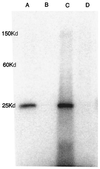Antibodies with infinite affinity
- PMID: 11447282
- PMCID: PMC37461
- DOI: 10.1073/pnas.151260298
Antibodies with infinite affinity
Abstract
Here we report an approach to the design and production of antibody/ligand pairs, to achieve functional affinity far greater than avidin/biotin. Using fundamental chemical principles, we have developed antibody/ligand pairs that retain the binding specificity of the antibody, but do not dissociate. Choosing a structurally characterized antibody/ligand pair as an example, we engineered complementary reactive groups in the antibody binding pocket and the ligand, so that they would be in close proximity in the antibody/ligand complex. Cross-reactions with other molecules in the medium are averted because of the low reactivity of these groups; however, in the antibody/ligand complex the effective local concentrations of the complementary reactive groups are very large, allowing a covalent reaction to link the two together. By eliminating the dissociation of the ligand from the antibody, we have made the affinity functionally infinite. This chemical manipulation of affinity is applicable to other biological binding pairs.
Figures






References
-
- Pluckthun A, Pack P. Immunotechnology. 1997;3:83–105. - PubMed
-
- Hoogenboom H R. Trends Biotechnol. 1997;15:62–70. - PubMed
-
- Rader C, Barbas C F., 3rd Curr Opin Biotechnol. 1997;8:503–508. - PubMed
-
- Crameri A, Cwirla S, Stemmer W P C. Nat Med. 1996;2:100–102. - PubMed
-
- Schier R, Bye J, Apell G, McCall A, Adams G P, Malmqvist M, Weiner L M, Marks J D. J Mol Biol. 1996;255:28–43. - PubMed
Publication types
MeSH terms
Substances
Grants and funding
LinkOut - more resources
Full Text Sources
Other Literature Sources

